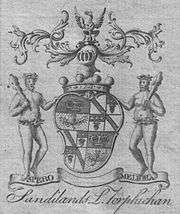Lord Torphichen

Lord Torphichen or Baron Torphichen[1] is a title in the Peerage of Scotland. It was created by Queen Mary in 1564 for Sir James Sandilands (to whom she was related), with remainder to his heirs and assigns whatsoever.[2][3][4]
The first Baron Sandilands had previously served as Preceptor of the Order of St John of Jerusalem, of Rhodes, and of Malta in Scotland, and took the title from the Torphichen Preceptory in West Lothian. He was succeeded by his great-nephew James Sandilands (who was also the current feudal baron of Calder). Thereafter the Lordship of Parliament of Torphichen and the Feudal Barony of Calder were conjoined, and all later lords were descended from the second Lord Torphichen. His great-grandson, the seventh Lord, was a strong supporter of the union with England. His grandson, the ninth Lord, and great-great-grandson, the 12th Lord, sat in the House of Lords as Scottish Representative Peers.[5]
Currently the title is held by the latter's great-grandson, the 15th Lord, who succeeded his father in 1975. He is Chief of Clan Sandilands and also holds the feudal title of Baron of Calder, granted in 1386.[4]
The title of the lordship of Parliament, Torphichen, is pronounced "Tor-fikken".
The ancestral seat of the Sandilands family is Calder House, historically called Caldour Castle, in Mid Calder, West Lothian.
Lords Torphichen (1564)
- James Sandilands, 1st Lord Torphichen (c. 1511–1579), succeeded by his elder brother's grandson[4]
- James Sandilands, 2nd Lord Torphichen (c. 1574–1617)
- James Sandilands, 3rd Lord Torphichen (c. 1597–1622)
- John Sandilands, 4th Lord Torphichen (c. 1598–1637), brother of third Lord[4]
- John Sandilands, 5th Lord Torphichen (1625–1649), died unmarried[4]
- Walter Sandilands, 6th Lord Torphichen (1629–1696), brother of fifth Lord, m. Anne Elphinstone, daughter of Alexander, 6th Lord Elphinstone[4]
- James Sandilands, 7th Lord Torphichen (d. 1753), married Lady Jean Hume, daughter of Patrick, Earl of Marchmont[4]
- Walter Sandilands, 8th Lord Torphichen (1707–1765)
- James Sandilands, 9th Lord Torphichen (1759–1815)
- James Sandilands, 10th Lord Torphichen (1770–1862)
- Robert Sandilands, 11th Lord Torphichen (1807– 24 December 1869), nephew of 10th Lord Torphichen[6]
- James Walter Sandilands, 12th Lord Torphichen (1846–1915)[7]
- John Gordon Sandilands, 13th Lord Torphichen (1886–1973)
- James Bruce Sandilands, 14th Lord Torphichen (1917–1975)[8]
- James Andrew Douglas Sandilands, 15th Lord Torphichen (b. 1946)
The heir presumptive is Margaret Elizabeth Grizel Sandilands, oldest daughter of the present Lord Torphichen.
Arms
BLAZON: Quarterly; 1st and 4th partie per fess azure and or, on the 1st a crown, and on the 2d a thistle, both proper, being the coat of augmentation; for as sir James Sandilands, lord of St. John, was great prior of Malta, in Scotland, the crown and thistle is born by his family as a badge of that office; the 2nd and 3rd quarters are counter-quartered, 1st and 4th argent, a bend azure, for Sandilands; 2nd and 3d the arms of Douglas.[4]
CREST: on a wreath, an eagle displayed or.[4]
SUPPORTERS: two savages, each wreath∣ed about the head and middle with laurel, and holding in his outer hand a batoon, all pro∣per.[4]
MOTTO: Spero meliora.[4]
See also
External links
Notes
- ↑ The London Gazette: no. 23622. p. 2876. 7 June 1870.
- ↑ Lodge, Edmund, The Genealogy of the Existing British Peerage and Baronetage, Oxford University, 1869, P. 541
- ↑ Debrett's Peerage at Google Books.
- 1 2 3 4 5 6 7 8 9 10 11 Douglas, Robert. The Peerage of Scotland: Containing an historical and genealogical account of the nobility of that kingdom. pp. 669–672. Retrieved 29 August 2016.
- ↑ Balfour Paul, James (1911). The Scots Peerage. pp. 378–398. Retrieved 29 August 2016.
- ↑ "Death of Lord Torphichen". The Times. The Times Digital Archive. 27 December 1869. p. 6.
- ↑ "Death of Lord Torphichen". The Times. The Times Digital Archive. 21 July 1915. p. 8.
- ↑ "Lord Torphichen". The Times. The Times Digital Archive. 15 July 1975. p. 16.